I just had a look at the NSW2 driver and it's interesting from a lot of aspects considering how compact it is.
But the 16dB fall from 10kHz to 20kHz is not good for matching with falling response in a horn.
That is what I thought but hoped it might work better.
I bought them to use in a more standard synergy design. 4 Auras per horn and a BMS 4524 aiming for a 1.5 to 2k crossover. Your thoughts on the sims are pretty much spot on. I have found they work really well in a 60x60 conical horn roughly 16" square.
These are my Hornresp plots which include the path length for the BMS which is 3.56cm. Due to the physical shape of the BMS driver I can actually mount the auras over the back of the horn throat to get the drivers virtually on top of each other. As you can see these have no filters and xmax is not exceeded even at 120w with response that will work with a 250Hz crossover to woofers.
1W power
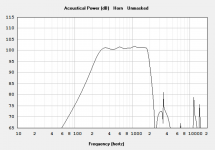
1W displacement
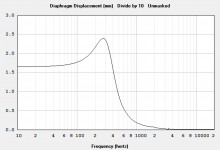
120W power
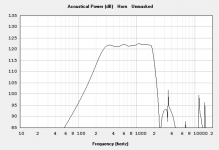
120W displacement
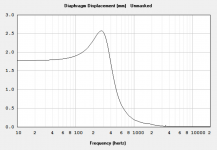
Hornresp input

BMS 4524
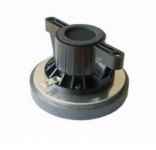
It is going to take me a while before I get out of sim land but so far I think these will work well together and I have hope that I will end up with something good for very little money. I bought the auras when they were on sale for $15 each and the 4524 is only 50EUR each so it is still a pretty low budget system.
But the auras tapped into the waveguide with a dome at the apex is very interesting too....
I'd pick 4 cycles. Not even sure why, except that when I use the filters in REW's filtered IR tab, move back to see the impulse it gets you this picture:

Filtered response of 8000 Hz 1/3 smoothing. As presented on the Impulse tab after setting the filter (left bottom) on the Filtered IR tab.
This gives me the impression a 4 cycle filter controls most of what the impulse is all about. Counting the above sine shapes. However, this is still a filtered response with smoothing applied. But noticing the time it takes those 4 cycles matches the time of a 4 cycle response at 8000 Hz exactly.
This example is done on a loopback test of my DAC.

Filtered response of 8000 Hz 1/3 smoothing. As presented on the Impulse tab after setting the filter (left bottom) on the Filtered IR tab.
This gives me the impression a 4 cycle filter controls most of what the impulse is all about. Counting the above sine shapes. However, this is still a filtered response with smoothing applied. But noticing the time it takes those 4 cycles matches the time of a 4 cycle response at 8000 Hz exactly.
This example is done on a loopback test of my DAC.
Fluid,
That's a nice result to see that the little Aura's can push 120dB+ at 300Hz. Quite amazing actually - probably the 5mm xmax helps a lot. You should consider trying a dome tweeter rather than a compression driver - the harmonic distortion on the dome will be much less I suspect and it will sound better. I don't know if you can push 125dB out of it, probably not but for home use, probably just fine given a +10dB boost on 90dB sensitivity already.
Look forward to seeing your build. How do you mount those drivers - they have no screw bezel - just press fit and have a clamp on the back?
That's a nice result to see that the little Aura's can push 120dB+ at 300Hz. Quite amazing actually - probably the 5mm xmax helps a lot. You should consider trying a dome tweeter rather than a compression driver - the harmonic distortion on the dome will be much less I suspect and it will sound better. I don't know if you can push 125dB out of it, probably not but for home use, probably just fine given a +10dB boost on 90dB sensitivity already.
Look forward to seeing your build. How do you mount those drivers - they have no screw bezel - just press fit and have a clamp on the back?
I'd pick 4 cycles. Not even sure why, except that when I use the filters in REW's filtered IR tab, move back to see the impulse it gets you this picture:

Filtered response of 8000 Hz 1/3 smoothing. As presented on the Impulse tab after setting the filter (left bottom) on the Filtered IR tab.
This gives me the impression a 4 cycle filter controls most of what the impulse is all about. Counting the above sine shapes. However, this is still a filtered response with smoothing applied. But noticing the time it takes those 4 cycles matches the time of a 4 cycle response at 8000 Hz exactly.
This example is done on a loopback test of my DAC.
Ok, I can give 4 cycles a try.
Within the EQ window dialog, there are choices for smoothing - should I pick 1/6th octave, variable, psychoacoustic, etc?
Here is 4 cycle with variable smoothing, I think there is more ripple in predicted outcome the LF's but maybe that just wasn't visible before and really are just reflections.
Here is new EQ:
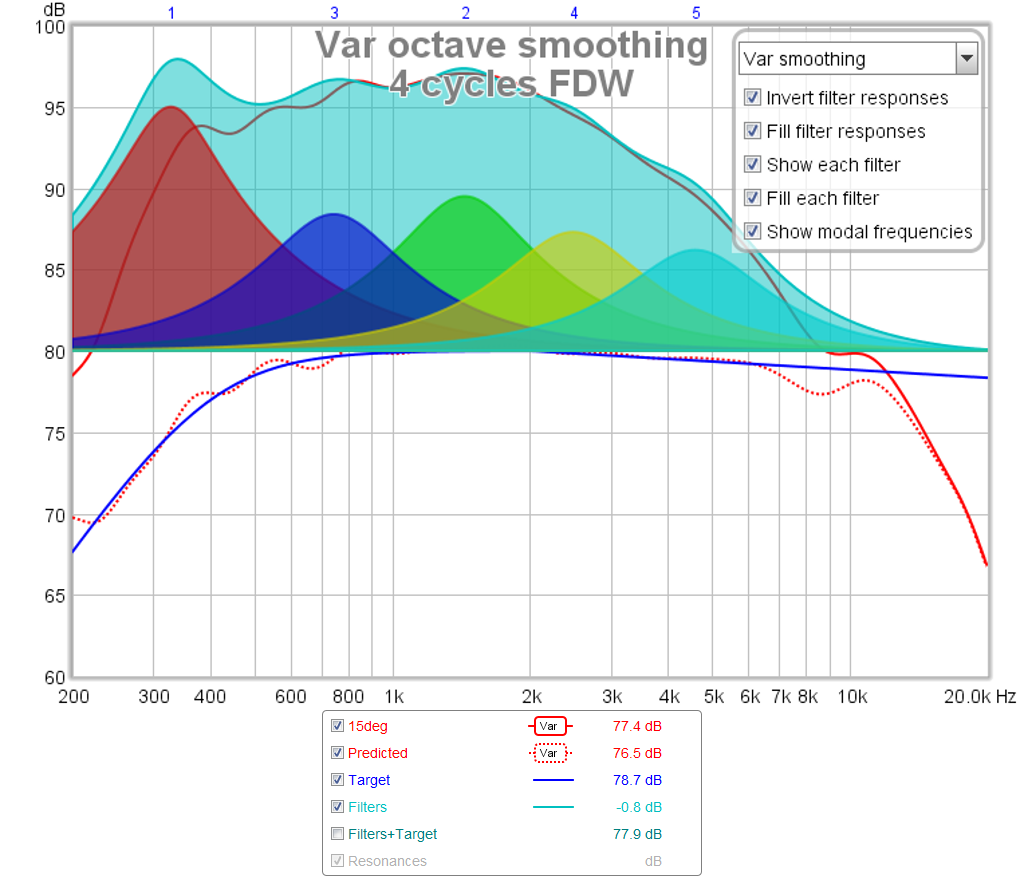
Here is predicted IR with new EQ:
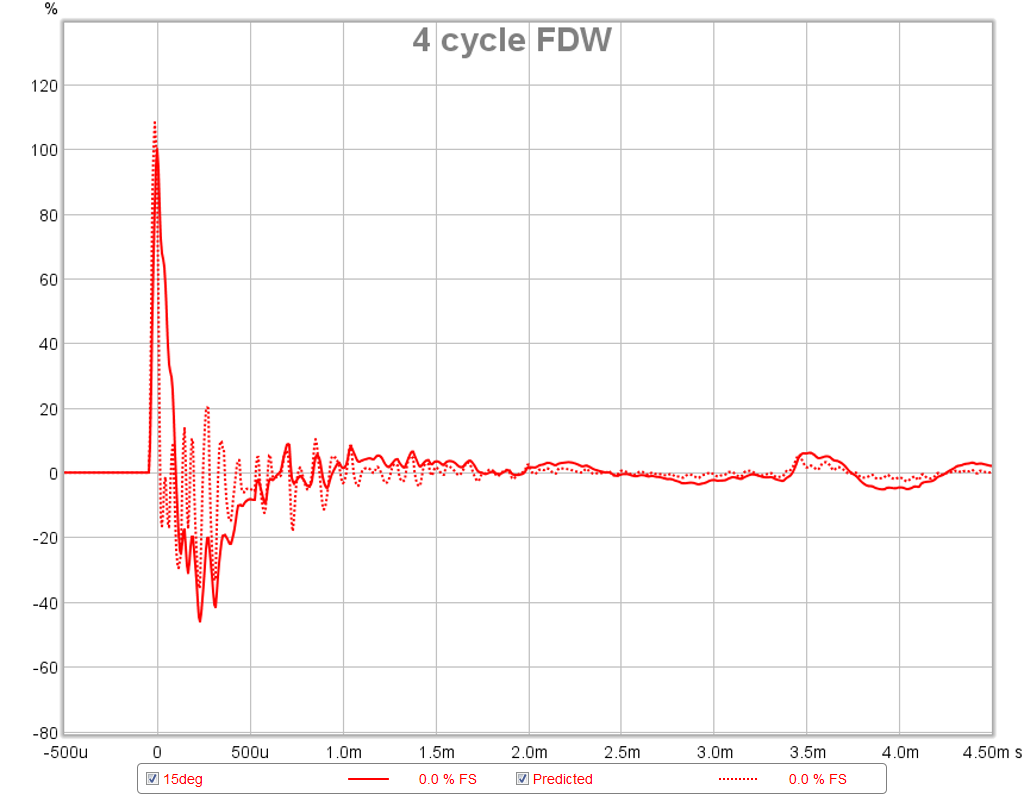
Edit:
Ok, here is 4 cycles, no smoothing, with added manual peak at 19200Hz, Q=0.65, G=8.5dB to pull up the HF's.
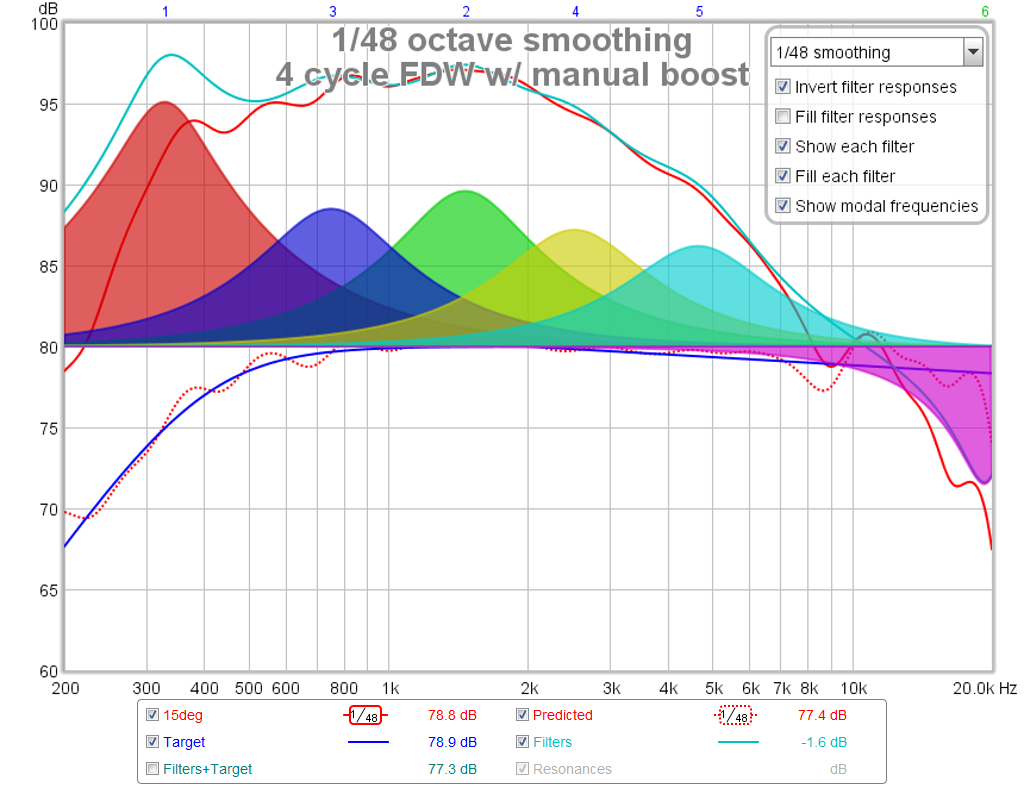
And here is the new miniDSP PEQ settings:
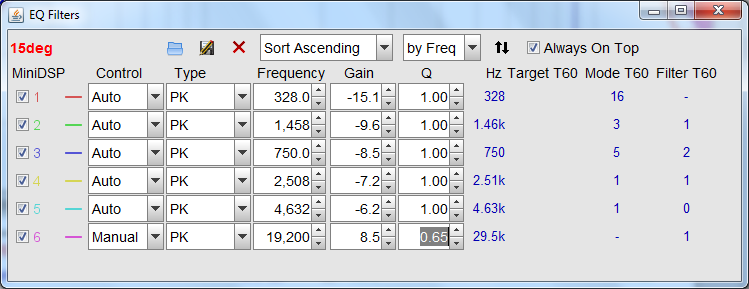
Attachments
-
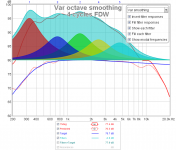 Auto-EQ-15deg-4cycle-variable-smoothing-sand.png184.6 KB · Views: 777
Auto-EQ-15deg-4cycle-variable-smoothing-sand.png184.6 KB · Views: 777 -
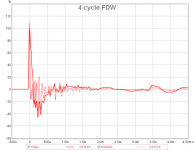 Auto-EQ-15deg-4cycle-variable-smoothing-IR.png84.3 KB · Views: 764
Auto-EQ-15deg-4cycle-variable-smoothing-IR.png84.3 KB · Views: 764 -
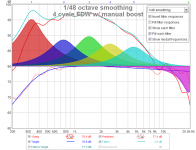 Auto-EQ-15deg-4cycle-variable-smoothing-sand-4-cycle-manual-boost.png173.1 KB · Views: 760
Auto-EQ-15deg-4cycle-variable-smoothing-sand-4-cycle-manual-boost.png173.1 KB · Views: 760 -
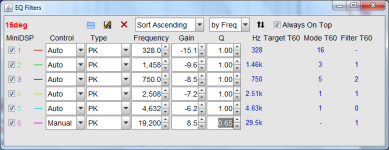 Auto-EQ-15deg-EQ-settings-4cycle-plus-manual.png55.5 KB · Views: 731
Auto-EQ-15deg-EQ-settings-4cycle-plus-manual.png55.5 KB · Views: 731
Last edited:
No smoothing, the frequency dependant window IS your smoothing.
4.3 cycle window = 1/6 octave FDW
You might have to use a manual EQ/boost to counter the drop off at high frequencies. Let's see how it goes on the 15 degree FR.

I'd add a manual PK centred at ~8700 and figure out the Q and gain to fill that dip (*). But use the no smoothing version. The frequency dependant window does all the smoothing you need.
(*) = Just try it and run tests afterward of the full polar and check HD with dip filled and without.
4.3 cycle window = 1/6 octave FDW
You might have to use a manual EQ/boost to counter the drop off at high frequencies. Let's see how it goes on the 15 degree FR.

I'd add a manual PK centred at ~8700 and figure out the Q and gain to fill that dip (*). But use the no smoothing version. The frequency dependant window does all the smoothing you need.
(*) = Just try it and run tests afterward of the full polar and check HD with dip filled and without.
Last edited:
I ran out of PEQ's for this bank. In miniDSP there is a second global PEQ that I can use to add the boost to fill in the dip.
Do use the non smoothed graph as the base for the actual EQ. And don't be afraid to edit the actual values (set them to manual) if you think you can do a little better.
Figure out the dip in this EQ session. Might set it to generic to have more available. We're on a test run here... 😉
Were there large changes in the predicted waterfall plot?
Figure out the dip in this EQ session. Might set it to generic to have more available. We're on a test run here... 😉
Were there large changes in the predicted waterfall plot?
Last edited:
That's a nice result to see that the little Aura's can push 120dB+ at 300Hz. Quite amazing actually - probably the 5mm xmax helps a lot.
I liked the look of the sim Hulkss was posting in the Unity midrange thread and after some sims of my own I couldn't find anything better. The xmax is actually 3mm 5mm is maximum excursion not linear though. Once it got over 120dB I stopped adding power as I will have no need of it but interesting to see.
How do you mount those drivers - they have no screw bezel - just press fit and have a clamp on the back?
No they have a square mounting bezel with screw holes. Sometimes the pictures don't really show it but this is what they look like from the front
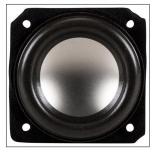
Interesting about the dome I hadn't really thought about it before but with a crossover above 1.5k could probably work. Any thoughts on suitable domes?
I have some Seas millenium tweeters that could be liberated from my Orions for a quick test as they work with a 1.6K crossover but I won't be buying any more of them at the price.
I haven't bought the BMS drivers yet so I can always try a dome out first. Probably harder to sim a dome as the path length will be somewhat unknown.
Yes, it did clean up the waterfall significantly but still looks a mess. I will play with the manual PEQ some more but you are right this is a test case. I am not even using the W2-852SH anymore so maybe a bit of waste - really just training for me to go through the mechanics of doing it when I get the correct measurement with the SB65 again,
Nice drawns of the horn!! I see you use two ports for a 8 inch woofer? is this better then one each speaker or better for the radiation pattern?.
succes here, box looks like one of the speakers from laurel and hardy time, neat.
succes here, box looks like one of the speakers from laurel and hardy time, neat.
I liked the look of the sim Hulkss was posting in the Unity midrange thread and after some sims of my own I couldn't find anything better. The xmax is actually 3mm 5mm is maximum excursion not linear though. Once it got over 120dB I stopped adding power as I will have no need of it but interesting to see.
No they have a square mounting bezel with screw holes. Sometimes the pictures don't really show it but this is what they look like from the front
View attachment 525210
Interesting about the dome I hadn't really thought about it before but with a crossover above 1.5k could probably work. Any thoughts on suitable domes?
I have some Seas millenium tweeters that could be liberated from my Orions for a quick test as they work with a 1.6K crossover but I won't be buying any more of them at the price.
I haven't bought the BMS drivers yet so I can always try a dome out first. Probably harder to sim a dome as the path length will be somewhat unknown.
I don't know if you have access to Dayton stuff in Australia but you can't go wrong with an RS28A. Great tweeter in general at any price and can be used in other speaker projects. Has nice aluminum round flange that should make rear mounting easy. I would also pick a hard dome like aluminum vs a soft fabric dome as the pressure from the mid ports would deflect and squash it causing IMD.
https://www.parts-express.com/pedoc...s28a-aluminum-dome-tweeter-specifications.pdf
There is also the Tymphany NE19VTC-04 aluminum dome that may work - a little lower sensitivity though.
https://www.parts-express.com/pedocs/specs/264-1008-vifa-ne19vtc-04-specifications-46526.pdf
Yes, it did clean up the waterfall significantly but still looks a mess. I will play with the manual PEQ some more but you are right this is a test case. I am not even using the W2-852SH anymore so maybe a bit of waste - really just training for me to go through the mechanics of doing it when I get the correct measurement with the SB65 again,
It will be interesting to see what a (little) boost would do at that dip, as the minimum phase does show a wiggle there. We would want to straighten out that phase (if possible) by that IIR PEQ.
Nice drawns of the horn!! I see you use two ports for a 8 inch woofer? is this better then one each speaker or better for the radiation pattern?.
succes here, box looks like one of the speakers from laurel and hardy time, neat.
Two ports just to get enough cross sectional area and to keep each hole smaller to reduce impact on waveguide polars. The speaker design and exterior shape is pure fancy and whim on my part. Bushmeister is doing the actual building so I imagine more rectilinear prismatic boxes. Perhaps a slanted panel over the woofers like I did to save volume. Doing a full rounded cabinet would require either fiberglass or bendy MDF/plywood, or foam core 🙂
How is your phase plug on the Trynergy coming along?
Based on the above analysis, it appears that the dip starts to show up in earnest at 3 cycles and the minimum phase is pretty consistent here. It would seem that to first order, an EQ to flatten the 3 cycle FDW would be a good gentle touch to get the system to go in the right direction to correct and help flatten the minimum phase, which you are proposing as the goal to shoot for best sound quality.
This is really helpful because it helps to separate what is correctable from the intrinsic behavior of the driver in WG vs what is really uncorrectable (without room treatments/positioning).
I don't understand why y'all aren't using actual gated, un-smoothed data here. It's not like these speakers are so large that they can't be moved away from boundaries to get 4-5ms of clean data. Then you would know exactly what you have (over most of the freq range) without guessing what's the room and what's not. Fdw could then be used for balancing the level on the low end.
It's because what Wesayso is suggesting is to EQ at listening position which has a mix of reflections and direct sound. I measured at 0.5m and with 5ms hating can get rid of all first reflections. But I guess at LP or would look different and what we want here is a broad stroke of a how to help the response of not just the direct sound. At least that is how I am interpreting this.
Mondo,
I think you are suggesting an aperiodic vented rear chamber ? With current design Bushmeister is making the woofers need to be isolated from the SB65 or all that pressure will cause distortion by pushing the cone around. Unless the SB65 rear aperiodic chamber was vented outside.
But to make an aperiodic rear chamber doesn't require a bowl with vented and stuffed holes. A simple short Dagger TL maybe 10:1 with lots of stuffing and foam placed across exit terminus can do same thing. I have measured its ability to flatten an impedance peak. The sealed one with the wool roll and lots of stuffing can also achieve very good impedance flattening. Knowing how much rigor Bushmeister puts into his builds we can expect an impedance sweep of the SB65 in the Tupperware bowl I am sure of it.
No, I mustn't have been clear
I'm talking about a sphere of two halves,one half compartmentalized into pigeon holes for foam or similar.
The remaining volume could be sealed or vented.
It's because what Wesayso is suggesting is to EQ at listening position which has a mix of reflections and direct sound. I measured at 0.5m and with 5ms hating can get rid of all first reflections. But I guess at LP or would look different and what we want here is a broad stroke of a how to help the response of not just the direct sound. At least that is how I am interpreting this.
Well, I'm not sure hating is enough (lol). Wouldn't that be something! 😀
We all hate reflections right? Ah well, not all of them...
Two ports just to get enough cross sectional area and to keep each hole smaller to reduce impact on waveguide polars. The speaker design and exterior shape is pure fancy and whim on my part. Bushmeister is doing the actual building so I imagine more rectilinear prismatic boxes. Perhaps a slanted panel over the woofers like I did to save volume. Doing a full rounded cabinet would require either fiberglass or bendy MDF/plywood, or foam core 🙂
How is your phase plug on the Trynergy coming along?
Hi Faseplug is destroyed why try to saw, this is because the plug was mdf, this material is very fragile, now I have oak, (do I write it right).
But my feelings say also that it maybe do nog go to highest point, but 15 Khz is already very neat, when the compression is high speaker will maybe do make a lot of IM like the old compression horns did, so I try the newest plug design or do experiment with something else like slits.
The model of the box is very nice, it fits is mucho rooms, oldfashion or not.
grtz kees
Last edited:
- Home
- Loudspeakers
- Multi-Way
- A Bookshelf Multi-Way Point-Source Horn